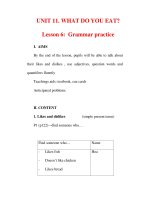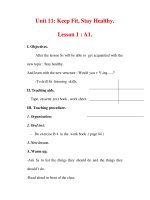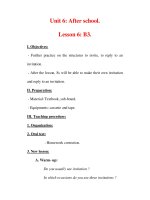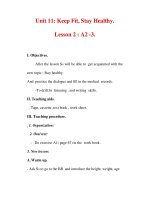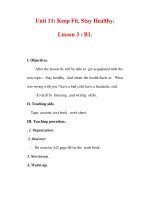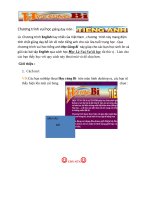TIẾNG ANH 6 GLOBAL SUCCESS_KẾ HOẠCH BÀI DẠY- UNIT 11
Bạn đang xem bản rút gọn của tài liệu. Xem và tải ngay bản đầy đủ của tài liệu tại đây (373.82 KB, 101 trang )
UNIT 11: OUR GREENER WORLD
Lesson 1: Getting started – Let’s go green!
Lesson aim(s)
By the end of the lesson, students will be able to:
- use the lexical items related to the topic Our Greener world.
- guess the meaning of new words based on clues including pictures and surr
- pronounce the sounds /a:/ and /æ/ correctly in isolation and in context.
Language analysis
Form
1. reusable (a)
2. plastic (n)
Meaning
able to be used again or more than once.
a synthetic material made from a wide
range of organic polymers such as
polyethylene, PVC, nylon, etc.
Pronunciation
/riːˈjuːzəb(ə)l/
/ˈplastɪk/
Materials (referenced)
-
Grade 6 textbook, Unit 11, Getting started
Pictures, maps and CD player
sachmem.vn
Anticipated difficulties
1. Students may lack
knowledge and
experiences about the
3Rs.
2. Teacher should get
some general
knowledge of GOING
GREEN.
Solutions
Prepare some hand-outs in which key language of
the key language of giving directions
- Reduce. Purchase products that
require less packaging or to limit
the waste you are producing.
- Reuse. Use a travel mug or
reusable water bottle and avoid
single-use bags.
- Recycle. Paper, plastic, glass,
magazines, electronics, and more
can be processed into new
products while using fewer natural
resources and less energy.
1
G: Generate less waste
R: Recycle everything that cannot be reused
E: Educate the community on eco-friendly options
E: Evaluate the environmental impact of actions
N: Nourish discussions and activities that
integrate
Board Plan
Date of teaching
UNIT 11: Our greener world
Lesson 1: Getting started – Let’s go green!
* Warm-up
I. Vocabulary
1. reusable [riːˈjuːzəb(ə)l] (a): có thể tái sử dụng
2. plastic [ˈplastɪk] (n): (chất liệu) nhựa
*plastic bag: túi ni lông
II. Practice
Task 1: Listen and complete the following sentences.
Task 2: Read and do the matching.
Task 3: Read the conversation, discuss the way to help the environment.
Task 4: Find someone who …
* Homework
Stage
Stage aim
Procedure
Warm-up
To set the
context for
the listening
and reading
text.
* Chitchatting:
Do you like to live in a
green world? Why or
why not?
*Introduction:
Review the previous
unit before Ss open
their books. Write
"Our greener world"
on the board. Ask
students what 'green'
means to them. Write
their answers on the
board. Explain that
To introduce
the topic of
the unit.
2
Interaction
Time
T-Ss
5
mins
Ss-Ss
Presentation
(Vocabpre-teach)
To introduce
the new
words.
Practice
To practice
the targeted
language and
the
background
knowledge of
going green.
"green” has a lot of
meanings. In this unit
it means relating to
the protection of the
environment. Write
"Let's go green!" on
the board and elicit
the meaning of 'go
green' from students.
Tell students that 'go
green' means: to do
more to protect
nature and the
environment. Let
students open their
books and start the
lesson.
* VOCABULARY:
Teacher introduces
the vocabulary:
1. reusable (a): có thể
tái sử dụng
2. plastic (n): (chất
liệu) nhựa
*plastic bag: túi ni
lông
GETTING STARTED
Let's 'go green'!
Activity 1.
Ask students to look
at the picture on Page
48 and answer the
questions below:
1. Who are they?
2. Where are they?
3. What might they
be talking about?
- Quickly
write
3
T-Ss
5
mins
15
mins
T-Ss
S
T-Ss
-
To help
students
deeply
understand
4
studen
ts’
answer
s to
Questi
on 3 on
the
board.
Play
the
recordi
ng.
Studen
ts
listen
and
read.
Ask
studen
ts if
their
guesse
s on
the
board
are
correct
.
Play
the
recordi
ng
twice
for
studen
ts to
listen
and
read
S
Ss-Ss
T-Ss
T- Ss
T-Ss
the text.
-
To draw
students’
attention to
the first
conditional.
5
along.
Have
studen
ts
underli
ne the
words
that
are
related
to the
topic
of the
unit
while
they
are
listenin
g and
reading
.
Invite
some
pairs of
studen
ts to
read
the
conver
sation
aloud.
Ask
studen
ts what
exactly
Mi and
Nick
talked
about.
T- Ss
Ss-Ss
T-Ss
Production
To develop
students’
knowledge of
the
vocabulary
about ways
to help the
environment.
6
Now
confir
m the
correct
answer
. (They
talked
about
ways to
go
green.)
Have
studen
ts say
the
words
in the
text
that
they
think
are
related
to the
topic
Our
greene
r
world.
Quickly
write
the
words
on one
part of
the
board.
Comm
ent on
T-Ss
-
To provide
students
with an
opportunity
to
communicate
with each
other, using
the
vocabulary
they have
learnt.
7
studen
ts’
answer
s.
Ask
studen
ts to
work
indepe
ndently
to fill
each
blank
with
the
word(s
) from
the
conver
sation.
Ask
them
how to
do this
exercis
e.
Teache
r may
once
again
instruc
t them
how to
do the
exercis
e: (1)
read
the
senten
T-Ss
-
8
ce and
identif
y the
kind of
inform
ation
to fill
the
blank;
(2)
read
the
conver
sation
and
locate
the
place
to find
the
word(s
) to fill
the
blank.
Model
with
the
first
senten
ce.
Allow
studen
ts to
share
answer
s
before
discuss
ing as a
class.
Write
the
correct
answer
s on
the
board.
Answer key:
1. on a picnic
2. reusable; natural
3. the check-out
4. a reusable
5. cycling
Activity 2: How to
make suggestions.
- Ask
studen
ts to
read
column
A and
B to
make
sure
they
unders
tand.
Ask
studen
ts to
give
their
answer
s
withou
t
reading
9
the
conver
sation
again.
Then
ask
them
to read
the
conver
sation
and
check
their
answer
s.
Confir
m the
correct
answer
s.
Answer key:
1. b 2. c
3. a
Model sentences:
First conditional
sentence
Tell students that
sentences 2 and 3 are
the first conditional
sentences but they
will learn about this
grammar point in A
closer look 2.
Activity 3:
10
-
Have
studen
ts look
-
11
at the
picture
s and
discuss
what
they
can see
in each
picture
in
pairs.
Invite
some
pairs to
share
their
answer
s with
the
whole
class.
Ask
studen
ts to
match
the
picture
s with
ways to
help
the
environ
ment.
Have
some
studen
ts
share
their
-
-
answer
s.
Confir
m the
correct
answer
s.
Ask
studen
ts to
add
any
other
ways to
save
the
environ
ment
they
know.
Answer key:
1. c
2. a
3. b
4. e
5. d
Game: Find someone
who…
•
Ask students
to work in groups.
Give each group a
handout with the
following table:
Find
someone
who…
uses
reusable
bags
12
Names
cycles
walks to
school
picks up
rubbish
plants trees
Model the way
to ask questions
and answers with a
student.
(e.g. Nam, do you use
reusable bags?, etc.)
• Ask each group to
choose one student
to ask the questions
and another student
to record the
answers and report
the results. Give
students 7 minutes
to ask and answer in
groups. Move
around to observe
and offer help.
• Ask students to get
more info buy
adding more simple
questions.
(When do you often
use them? How do
you find them
effective? …)
Invite students to
share their findings
to the class.
•
13
Consolidation
To
consolidate
what
students
have learnt in
the lesson.
-
-
14
Ask
one or
two
studen
ts to
tell the
class
what
they
have
learnt.
Ask
studen
ts to
say
aloud
some
words
they
remem
ber
from
the
lesson.
If there
is an
overhe
ad
project
or in
the
classro
om,
show
the
dialogu
e,
highlig
ht the
T-Ss
2
mins
Homework
To prepare
vocabulary
for the next
lesson.
key
words
related
to the
topic.
Go to the Internet
and search for 3Rs –
Go green to
understand more
about the topic.
15
T-Ss
1 min
UNIT 11: OUR GREENER WORLD
Lesson 2: A closer look 1
Lesson aim(s)
By the end of the lesson, students will be able to:
- pronounce the sounds /a:/ and /æ/ correctly in isolation and in
context;
- use the lexical items related to the topic Our Greener world;
- guess the meaning of new words based on clues including
pictures and surrounding words.
Language analysis
Form
1. reduce (v)
2. reuse (v)
3. recycle(v)
4. plastic bag
5. rubbish
Meaning
make smaller or less in amount, degree,
or size.
to use something again
to use something again for a
different purpose
a synthetic material made from a wide
range of organic polymers such as
polyethylene, PVC, nylon, etc.
material that is considered unimportant
or valueless
Pronunciation
/rɪˈdʒuːs/
/ˌriːˈjuːz/
/ˌriːˈsaɪ.kəl/
/ˈplæs.tɪk bæg/
/ˈrʌbɪʃ/
Materials (referenced)
- Grade 6 textbook, Unit 11, A closer look 1
- Pictures and a video clip
- sachmem.vn
Anticipated difficulties
1. Students may lack knowledge
about some lexical items.
Solutions
Provide students with the meaning and
pronunciation of some lexical items.
2. Students may have
underdeveloped listening,
speaking and co-operating skills.
16
Play the recording many
times if any necessary.
Encourage students to
work in pairs, in groups
3. Some students will excessively talk
in the class.
-
so that they can help
each other.
Provide feedback and
help if necessary.
Define expectation in
explicit detail.
Have excessive talking
students practise.
Continue to define
expectations in small
chunks (before every
activity).
Board Plan
Date of teaching
Unit 11: Our greener world
Lesson 2: A closer look 1
* Warm-up
Chit-chatting
I. Vocabulary
Task 1: Match the places below with the pictures.
Task 2: Write a word/ phrase under the pictures.
Task 3: Put the words into groups.
II. Pronunciation
Task 4: Listen and repeat the sentences.
Task 5: Listen and practice the conversation.
III. Production
Understanding each other
* Homework
Stage
Stage aim
Procedure
17
Interaction
Time
Warm-up
Lead in
To activate
students’ prior
knowledge and
vocabulary
related to the
topic, the
targeted
vocabulary and
its
pronunciation.
(Students have
prepared at
home)
To lead in the
lesson about
vocabulary.
Greetings
Chatting:
1. What
advantages does
a green world
have?
2. What does it
look like?
Teacher
encourages
students to give
short answers, tries
to call as many
students as she
can.
1. Fresh air, healthy
food, more
exercise, less
stress and so on
2. A lot of trees.
People are not in
a hurry, no traffic
jams,…
- Teac
her
lead
s
stud
ents
into
18
T-Ss
Ss-Ss
T-Ss
5
mins
1
mins
Presentation
(Vocabpre-teach)
To teach
students some
places and
adjectives
describing ones
in a
neighbourhood.
the
less
on
by
telli
ng
the
m
that
“In today lesson,
we are going to
learn more about
3Rs and how we
can save the
environment.
VOCABULARY
- Hav
e
stud
ents
read
the
infor
mati
on
in
the
tabl
e
and
dra
wa
line
fro
ma
sym
bol
in
colu
19
T-Ss
5
mins
mn
A to
the
mat
chin
g
wor
d in
colu
mn
B
and
its
mea
ning
in
colu
mn
C.
Stud
ents
wor
k in
pair
s to
com
pare
their
ans
wers
befo
re
givin
g
teac
her
the
ans
wers
20
.
Che
ck
and
writ
e
the
corr
ect
ans
wers
on
the
boar
d.
REDUCE: using less
of something
REUSE: using
something again
RECYCLE: creating
new products
from used
materials
- Elicit
the
diffe
renc
e
bet
wee
n
“rec
yclin
g”
and
“reu
sing
”
fro
21
-
22
m
stud
ents
.
Expl
ain
the
diffe
renc
e
bet
wee
n
thes
e
two
ter
ms
agai
n if
nece
ssar
y:
Recy
cling
mea
ns
repr
oces
sing
an
old
item
such
as a
new
spap
er, a
glas
s or
a
can
and
turn
ing
it
into
a
new
prod
uct.
For
exa
mpl
e,
used
pap
er is
brou
ght
to a
fact
ory
whe
re it
is
repr
oces
sed,
clea
ned
and
puri
fied.
This
pap
er is
then
23
-
24
used
to
mak
e
new
thin
gs
such
as
boo
ks or
new
spap
ers.
Reus
ing
mea
ns
avoi
ding
the
repr
oces
sing
proc
edur
e. It
is
whe
n
peo
ple
use
som
ethi
ng
over
and
over
agai
n
until
it
cann
ot
be
used
any
mor
e.
For
exa
mpl
e, a
used
plas
tic
bottl
e
can
be
used
agai
n as
flow
er
vase
s, or
a
butt
er
cont
aine
r
can
be
used
to
25

